Epigenetic-Hydrothermal Fluorite Veins in a Phosphorite Deposit from Balaton Highland (Pannonian Basin, Hungary): Signatures of a Regional Fluid Flow System in an Alpine Triassic Platform
Abstract
1. Introduction
2. Geological Background
2.1. Regional Geology
2.2. Geology of the Pécsely Locality
3. Materials and Methods
4. Results
4.1. Field Description, Mineralogy, and Petrography of the Fluorite Veins and Their Host Rock
4.2. Mineral Chemistry
4.3. Carbon and Oxygen Isotopes in Vein-Filling Carbonates
4.4. Fluid Inclusion Petrography and Microthermometry
4.5. Raman Spectroscopy of Fluid Inclusions and Fluorite
5. Discussion
5.1. Formation Conditions of the Fluorite Veins
5.2. The Origin of H2 in Fluid Inclusions of Fluorite
5.3. Metallogenic Implications
6. Conclusions
- The δ18OPDB and δ13CPDB values of carbonate minerals from veins confirm their epigenetic-hydrothermal origin.
- Fluorite from the veins contains REEs in sub-ppm concentration. This low content of REE and their relative concentrations show a good match with the properties of fluorite in the Alpine-type Pb-Zn ore deposits.
- Color zoning of fluorite is associated with defects in the crystal structure.
- The results of fluid inclusion studies indicate that the primary and the S1 generation of secondary fluid inclusions of fluorite have a similar appearance (size, shape, phase ratio), and their entrapment took place from a homogeneous fluid. The relatively low homogenization temperatures with Ca-enriched, high salinity compositions are similar to fluid inclusion characteristics of saline basinal fluids that were also recorded in other areas of the Pannonian Basin and in the Alpine-type Pb-Zn deposits along the Periadriatic-Balaton Lineament
- Fluid inclusions of fluorite contain hydrogen gas; this rather unique feature can be related to the interaction of the parent fluids of the fluorite-bearing veins with the interaction between the fluorite vein-forming epigenetic process and the uranium-bearing phosphorite layers of the host strata and uranium enrichments in the basement rocks and also to the possibly in situ radiolysis of water within the fluid inclusions.
Author Contributions
Funding
Data Availability Statement
Acknowledgments
Conflicts of Interest
References
- Kiss, J.; Virágh, K. A uranium-bearing phosphatic rock in the Triassic of the Balaton Uplands around Pécsely. Bull. Hung. Geol. Soc. 1959, 89, 85–97. [Google Scholar]
- Molnár, Z.; Kiss, B.G.; Dunkl, I.; Czuppon, G.; Zaccarini, F.; Dódony, I. Geochemical characteristics of Triassic and Cretaceous phosphorite horizons from the Transdanubian Mountain Range (western Hungary): Genetic implications. Mineral. Mag. 2018, 82(S1), S147–S171. [Google Scholar] [CrossRef]
- Frisch, W.; Kuhlemann, J.; Dunkl, I.; Brügel, A. Palinspastic reconstruction and topographic evolution of the Eastern Alps during late Tertiary extrusion. Tectonophysics 1998, 297, 1–15. [Google Scholar] [CrossRef]
- Fodor, L.; Csontos, L.; Bada, G.; Györfi, I.; Benkovics, L. Tertiary tectonic evolution of the Pannonian basin system and neighbouring orogens: A new synthesis of paleostress data. In The Mediterranean Basins: Tertiary Extension within the Alpine; Orogen, B., Durand, L., Jolivet, F., Horváth, M., Séranne, Eds.; Geological Society Special Publications: London, UK, 1999; Volume 156, pp. 295–334. [Google Scholar]
- Haas, J.; Mioč, P.; Tomljenović, B.; Árkai, P.; Bércziné Makk, A.; Koroknai, B.; Kovács, S.; Rálisch-Felgenhauer, E. Complex structural pattern of the Alpine Dinaridic–Pannonian triple junction. Int. J. Earth Sci. 2000, 89, 377–389. [Google Scholar] [CrossRef]
- Benkó, Z.; Molnár, F.; Lespinasse, M.; Billström, K.; Pécskay, Z.; Németh, T. Triassic fluid mobilization and epigenetic lead-zinc sulphide mineralization in the Transdanubian Shear Zone (Pannonian Basin, Hungary). Geol. Carpath. 2014, 65, 177–194. [Google Scholar] [CrossRef]
- Kázmér, M.; Kovács, S. Permian-Paleogene paleogeography along the eastern part of the Insubric-Periadriatic lineament system: Evidence for continental escape of the Bakony-Drauzug unit. Acta Geol. Hung. 1985, 28, 71–84. [Google Scholar]
- Csontos, L.; Nagymarosy, A.; Horváth, F.; Kovác, M. Tertiary evolution of the Intracarpathian area: A model. Tectonophysics 1992, 208, 221–241. [Google Scholar] [CrossRef]
- Tari, G.; Bada, G.; Beidinger, A.; Csizmeg, J.; Danišik, M.; Gjerazi, I.; Grasemann, B.; Kováč, M.; Plašienka, D.; Šujan, M.; et al. The connection between the Alps and the Carpathians beneath the Pannonian Basin: Selective reactivation of Alpine nappe contacts during Miocene extension. Glob. Planet. Chang. 2021, 197, 103401. [Google Scholar] [CrossRef]
- Tari, G. Neoalpine tectonics of the Danube Basin (NW Pannonian Basin, Hungary). In Peri-Tethys Memoir 2: Structure and Prospects of Alpine Basins and Forelands; Ziegler, P.A., Horváth, F., Eds.; Mémoires du Muséum National d’histoire Naturelle: Washington, DC, USA, 1996; Volume 170, pp. 439–454. [Google Scholar]
- Csontos, L.; Vörös, A. Mesozoic plate tectonic reconstruction of the Carpathian region. Palaeogeogr. Palaeoclimatol. Palaeoecol. 2004, 210, 1–56. [Google Scholar] [CrossRef]
- Kovács, I.; Szabó, C.; Bali, E.; Falus, G.; Benedek, K.; Zajacz, Z. Palaeogene—Early Miocene igneous rocks and geodynamics of the Alpine—Carpathian Dinaric region: An integrated approach. Geol. Soc. Am. Spec. Pap. 2007, 418, 93–112. [Google Scholar]
- Köppel, V. Summary of lead isotope data from ore deposits of the Eastern and Southern Alps: Some metallogenic and geotectonic implications. In Mineral Deposits of the Alpine Epoch in Europe; Schneider, H.J., Ed.; Springer: Berlin/Heidelberg, Germany, 1983; pp. 162–269. [Google Scholar]
- Budai, T.; Haas, J. Triassic sequence stratigraphy of the Balaton Highland, Hungary. Acta Geol. Hung. 1997, 40, 307–335. [Google Scholar]
- Budai, T.; Vörös, A. Middle Triassic history of the Balaton Highland: Extensional tectonics and basin evolution. Acta Geol. Hung. 1992, 35, 237–250. [Google Scholar]
- Budai, T.; Vörös, A. Middle Triassic platform and basin evolution of the Southern Bakony Mountains (Transdanubian Range, Hungary). Riv. Ital. Paleont. Stratigr. 2006, 112, 359–371. [Google Scholar]
- Budai, T.; Császár, G.; Csillag, G.; Dudko, A.; Koloszár, L.; Majoros, G. Geology of the Balaton Highland. Explanation to the Geological Map of the Balaton Highland, 1:50,000; Occasional Papers; Hungarian Geological Institute: Budapest, Hungary, 1999; Volume 197, p. 257. [Google Scholar]
- Schroll, E.; Rantitsch, G. Sulphur isotope patterns from the Bleiberg deposit (Eastern Alps) and their implications for genetically affiliated lead-zinc deposits. Mineral. Petrol. 2005, 84, 18. [Google Scholar] [CrossRef]
- Korte, C.; Kozur, H.W.; Veizer, J. δ13C and δ18O values of Triassic brachiopods and carbonate rocks as proxies for coeval seawater and palaeotemperature. Palaeogeogr. Palaeoclimatol. Palaeoecol. 2005, 226, 287–306. [Google Scholar] [CrossRef]
- Hall, D.L.; Sterner, S.M.; Bodnar, R.J. Freezing point depression of NaCl-KCl-H2O solutions. Econ. Geol. 1988, 83, 197–202. [Google Scholar] [CrossRef]
- Naden, J. CalcicBrine: A Microsoft Excel 5.0 add-in for calculating salinities from microthermometric data in the system NaCl–CaCl2·H2O. In Proceedings of the Program and Abstracts of Biennial Pan-American Conference on Research on Fluid Inclusions, Madison, WI, USA, 30 May–1 June 1996. [Google Scholar]
- Potter, R.W., II; Clyne, M.A. Pressure correction for fluid inclusion homogenization temperature. In Proceedings of the Programs and Abstracts, International Association Genesis Ore Deposits Symposium, Snowbird, Alta, UT, USA, 14–19 August 1978; p. 146. [Google Scholar]
- Zhang, Y.G.; Frantz, J.D. Determination of homogenization temperatures and densities of supercritical fluids in the system NaCl-KCl-CaCl2-H2O using synthetic fluid inclusions. Chem. Geol. 1987, 64, 335–350. [Google Scholar] [CrossRef]
- Wolff, R.; Dunkl, I.; Kempe, U.; von Eynatten, H. The age of the latest thermal overprint of tin and polymetallic deposits in the Erzgebirge, Germany: Constraints from Fluorite (U-Th-Sm)/He Thermochronology. Econ. Geol. 2015, 110, 2025–2040. [Google Scholar] [CrossRef]
- McDonough, W.F.; Sun, S.S. The composition of the Earth. Chem. Geol. 1995, 120, 223–253. [Google Scholar] [CrossRef]
- McLennan, S.M. Relationships between the trace element composition of sedimentary rocks and upper continental crust. Geochem. Geophys. 2001, 2, 1–24. [Google Scholar] [CrossRef]
- Spötl, C.; Wennemann, T.W. Continuous-flow isotope ratio mass spectrometric analysis of carbonate minerals. Rapid. Commun. Mass. Spectrom. 2003, 17, 1004–1006. [Google Scholar] [CrossRef] [PubMed]
- Vanko, D.A.; Bodnar, R.J.; Sterner, S.M. Synthetic fluid inclusions: VIII. Vapor-saturated halite solubility in part of the system NaCl-CaCl2-H2O, with application to fluid inclusions from oceanic hydrothermal systems. Geochim. Cosmochim. Acta 1988, 52, 2451–2456. [Google Scholar] [CrossRef]
- Oakes, C.S.; Bodnar, J.R.; Simonson, J.M. The system NaCl-CaCl2-H2O: I. The ice liquidus at 1 atm total pressure. Geochim. Cosmochim. Acta 1990, 54, 603–610. [Google Scholar] [CrossRef]
- Mernagh, T.P.; Wilde, A.R. The use of the Raman microprobe for the determination of salinity in fluid inclusions. Geochim. Cosmochim. Acta 1989, 53, 765–771. [Google Scholar] [CrossRef]
- Sun, Q.; Zhao, L.; Li, N.; Liu, J. Raman spectroscopic study for the determination of Cl− concentration (molarity scale) in aqueous solutions: Application to fluid inclusions. Chem. Geol. 2010, 272, 55–61. [Google Scholar] [CrossRef]
- Čermáková, Z.; Bezdička, P.; Němec, I.; Hradilová, J.; Šrein, V.; Blažek, J.; Hradil, D. Naturally irradiated fluorite as a historic violet pigment: Raman spectroscopic and X-ray diffraction study. J. Raman Spectrosc. 2015, 46, 236–243. [Google Scholar] [CrossRef]
- Roedder, E. Fluid Inclusions. Rev. Mineral. 1984, 12, 644. [Google Scholar]
- Hill, G.T.; Andrew, R.C.; Philip, R.K. Geochemistry of southwestern New Mexico fluorite occurrences: Implications for precious metals exploration in fluoritebearing systems. J. Geochem. Explor. 2000, 68, 1–20. [Google Scholar] [CrossRef]
- Constantopoulos, J. Fluid inclusions and rare earth element geochemistry of fluorite from south-central Idaho. Econ. Geol. 1988, 83, 626–636. [Google Scholar] [CrossRef]
- Castorina, F.; Masi, U.; Padalino, G.; Palomba, M. Trace-element and Sr–Nd isotopic evidence for the origin of the Sardinian fluorite mineralization (Italy). Appl. Geochem. 2008, 23, 2906–2921. [Google Scholar] [CrossRef]
- Parekh, P.P.; Möller, P.; Dulski, P. Distribution of trace elements between carbonate and non-carbonate phases of limestone. Earth. Planet. Sci. Lett. 1977, 34, 39–50. [Google Scholar] [CrossRef]
- Wilkinson, J.J. Fluid inclusions in hydrothermal ore deposits. Lithos 2001, 55, 229–272. [Google Scholar] [CrossRef]
- Kuhlemann, J.; Vennemann, T.; Herlec, U.; Zeeh, S.; Bechstädt, T. Variations of sulfur isotopes, trace element compositions, and cathodoluminesence of Mississippi Valley type lead-zinc ores from the Drau-Range, Eastern Alps (Slovenia—Austria): Implications for ore deposition on a regional versus micro scale. Econ. Geol. 2001, 96, 1931–1941. [Google Scholar]
- Dunkl, I.; Farics, É.; Józsa, S.; Lukács, R.; Haas, J.; Budai, T. Traces of Carnian volcanic activity in the Transdanubian Range, Hungary. Int. J. Earth Sci. 2019, 108, 1451–1466. [Google Scholar] [CrossRef]
- Horita, J. Oxygen and carbon isotope fractionation in the system dolomite-water-CO2 to elevated temperatures. Geochim. Cosmochim. Acta 2014, 129, 111–124. [Google Scholar] [CrossRef]
- Budai, T.; Haas, J.; Vörös, A.; Molnár, Z. Influence of upwelling on the sedimentation and biotaof the segmented margin of the western Neotethys: Acase study from the Middle Triassic of the Balaton Highland. Facies 2017, 63, 22. [Google Scholar] [CrossRef]
- Dubessy, J.; Pagel, M.; Beny, J.M.; Christensen, H.; Hickel, B.; Kosztolanyi, C.; Poty, B. Radiolysis evidenced by H2-O2 and H2-bearing fluid inclusions in three uranium deposits. Geochim. Cosmochim. Acta 1988, 52, 1155–1167. [Google Scholar] [CrossRef]
- Richard, A. Radiolytic (H2, O2) and other trace gases (CO2, CH4, C2H6, N2) in fluid inclusions from unconformity related U deposits. Procedia Earth Planet. Sci. 2017, 17, 273–276. [Google Scholar] [CrossRef]
- Majoros, G. Problems of Permian sedimentation in the Transdanubian Central Mountains: A palaeogeographic model and some conclusions. Bull. Hung. Geol. Soc. 1980, 110, 323–341. [Google Scholar]
- Palinkaš, L.A.; Damyanov, Z.K.; Borojević Šoštarić, S.; Strmić Palinkaš, S.; Marinova, I. Divergent drift of Adriatic-Dinaridic and Moesian carbonate platforms during the rifting phase witnessed by triassic MVT Pb-Zn and SEDEX deposits; a metallogenic approach. Geol. Croat. 2016, 69, 75–78. [Google Scholar] [CrossRef]
- Schroll, E. Alpine type Pb-Zn-deposits (APT) hosted by Triassic carbonates. In Mineral Deposit Research: Meeting the Global Challenge, Proceedings of the Eighth Biennial SGA Meeting, Beijing, China, 18–21 August 2005; Springer: Berlin/Heidelberg, Germany, 2005; pp. 175–178. [Google Scholar]
- Molnár, F. Characteristics of Variscan and Palaeogene fluid mobilization processes in the Velence Mts., Hungary: A comparative fluid inclusion study. Acta Mineral. Petrogr. 2004, 45, 55–63. [Google Scholar]
- Hein, U.F.; Schneider, H.J. Fluorine Anomalies Accompanying the Alpine Pb-Zn Deposits Compared to the Geochemistry of Their Fluorites. In Mineral Deposits of the Alps and of the Alpine Epoch in Europe; Special Publication No. 3 of the Society for Geology Applied to Mineral Deposits; Schneider, H.J., Ed.; Springer: Berlin/Heidelberg, Germany, 1983. [Google Scholar]
- Möller, P.; Morteani, G. Onthegeochemical fractionation of rare earth elements during the formation of Ca minerals and its application to problems of the genesis of ore deposits. In The Significance of Trace Elements in Solving Petrogenetic Problems and Controversies; Augustithis, S.S., Ed.; Theophrastus Publications: Athens, Greece, 1983; pp. 747–791. [Google Scholar]
- Oppizzi, P.; Camana, G.; Neri, P.; Rossi, C.; Rodeghiero, F.; Bernasconi, E. Le mineralizzazioni a barite e fluorite del Monte San Giorgio (Canton Ticino meridionale). Geol. Insubrica 1999, 4, 79–89. [Google Scholar]
- Bigi, G.; Castellarin, A.; Coli, M.; Dal Piaz, G.V.; Vai, G.B. Structural Model of Italy scale 1:500,000, sheet 2. C.N.R. Progett. Final. Geodin. 1990, 114. [Google Scholar] [CrossRef]
- Cerny, I. Die karbonatgebundenen Blei-Zink-Lagerstaetten des alpinen und ausser-alpinen Mesozoikums; Die Bedeutung ihrer Geologie, Stratigraphie und Faziesgebundenheit fuer Prospektion und Bewertung. Carbonate-bound lead-zinc deposits of the Alpine and extra-Alpine Mesozoic; implications for prospecting and evaluation of their stratigraphy and facies relationships. Arch. für Lagerstättenforschung Geol. Bundesanst. 1989, 11, 5–125. [Google Scholar]
- Haas, J.; Kovács, S.; Krystyn, L.; Lein, R. Significance of Late Permian–Triassic facies zones in terrane reconstructions in the Alpine—North Pannonian domain. Tectonophysics 1995, 242, 19–40. [Google Scholar] [CrossRef]
- Mandl, G.W. The Alpine sector of the Tethyan shelf—examples of Triassic to Jurassic sedimentation and deformation from the Northern Calcareous Alps. Mitt. Gesellsch. Geol. Bergb. Öst. 2000, 92, 61–77. [Google Scholar]
- Gawlick, H.J. Paläogeographie der Ober-Trias Karbonatplattform in den Nördlichen Kalkalpen. Mitt. Gesellsch. Geol. Bergb. Öst. 2000, 44, 45–95. [Google Scholar]
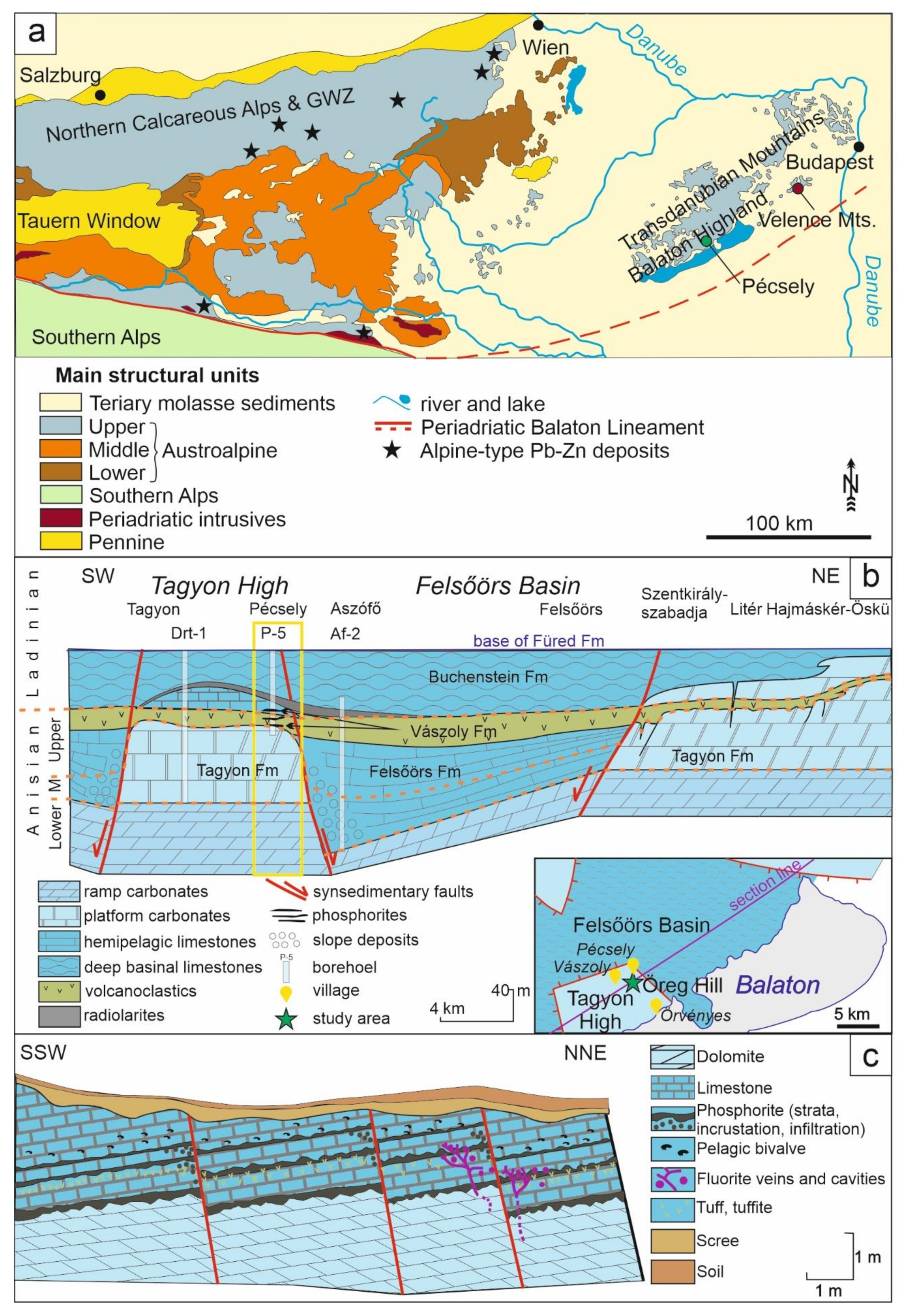
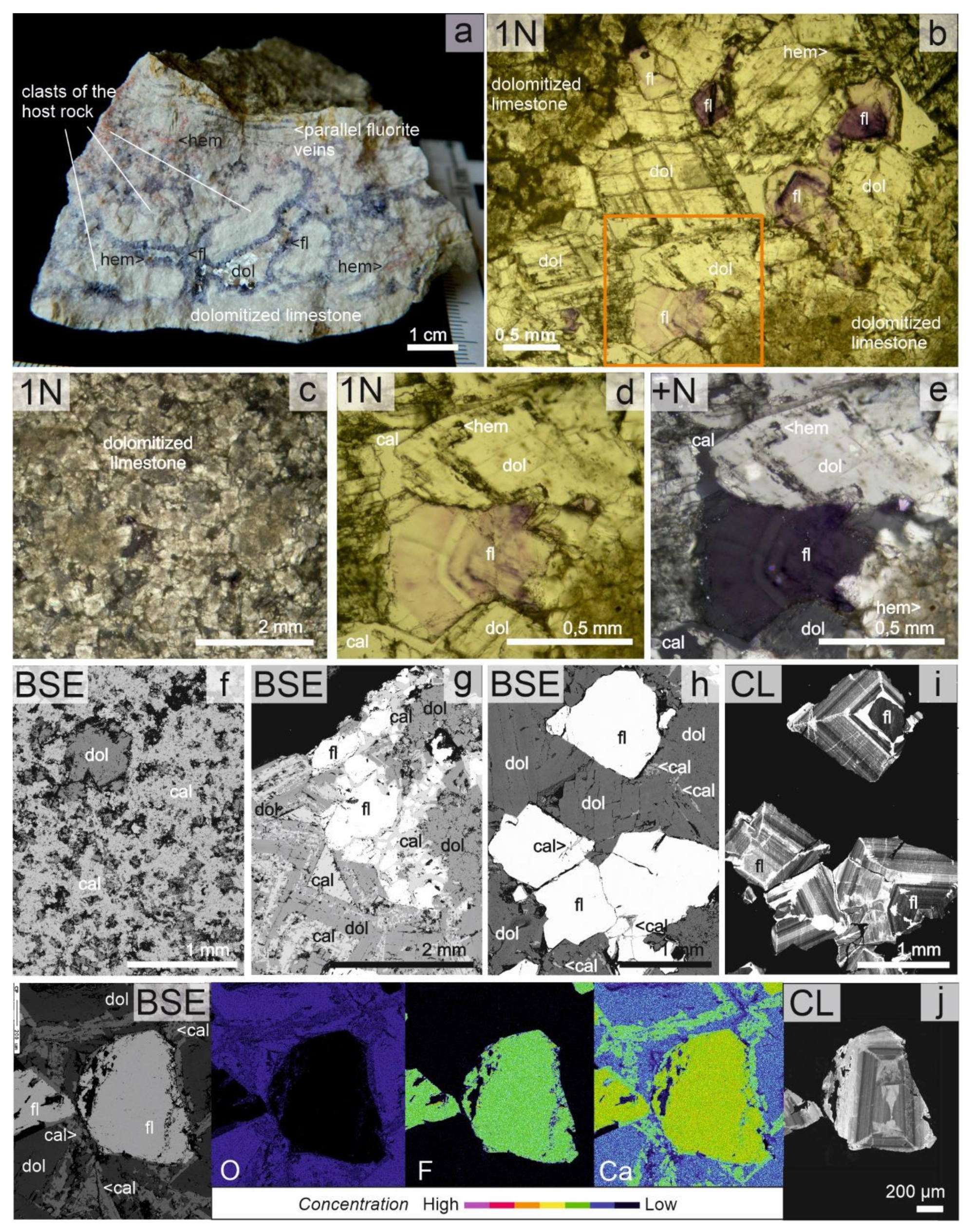
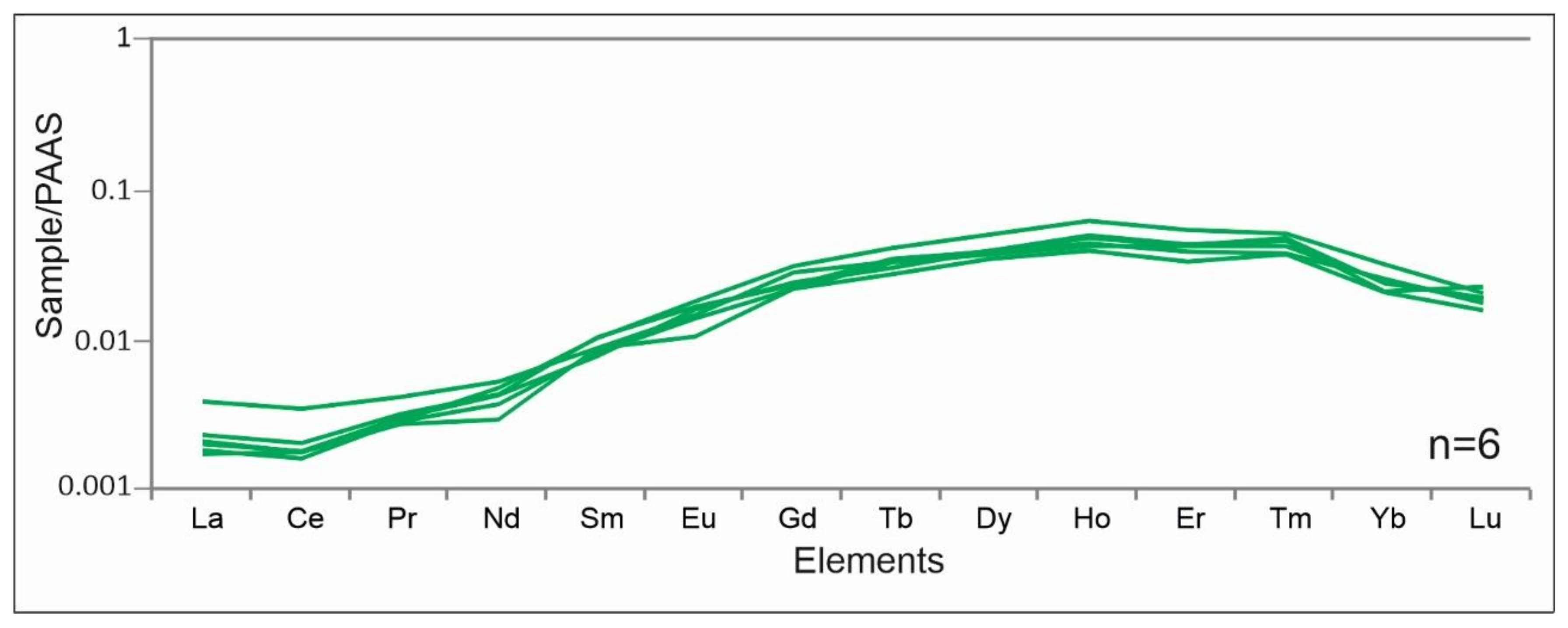
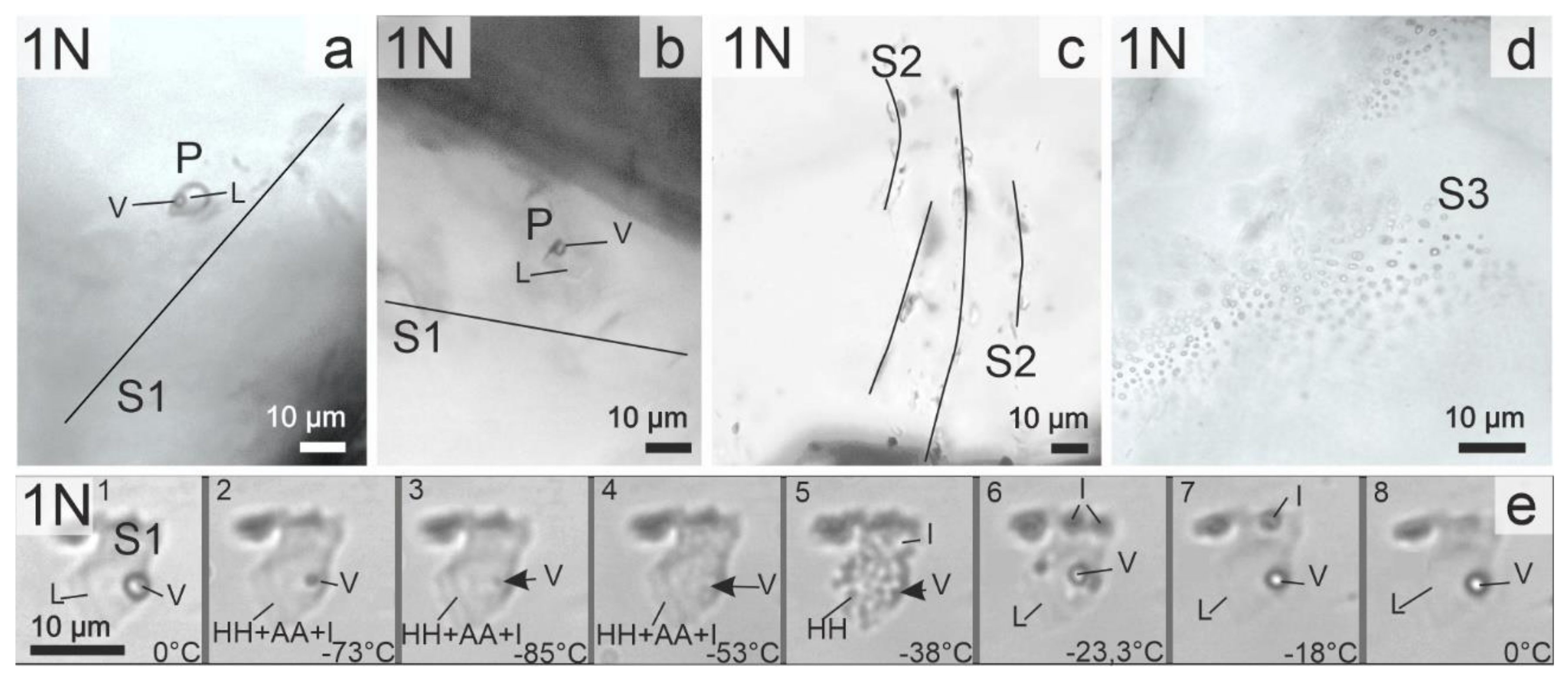
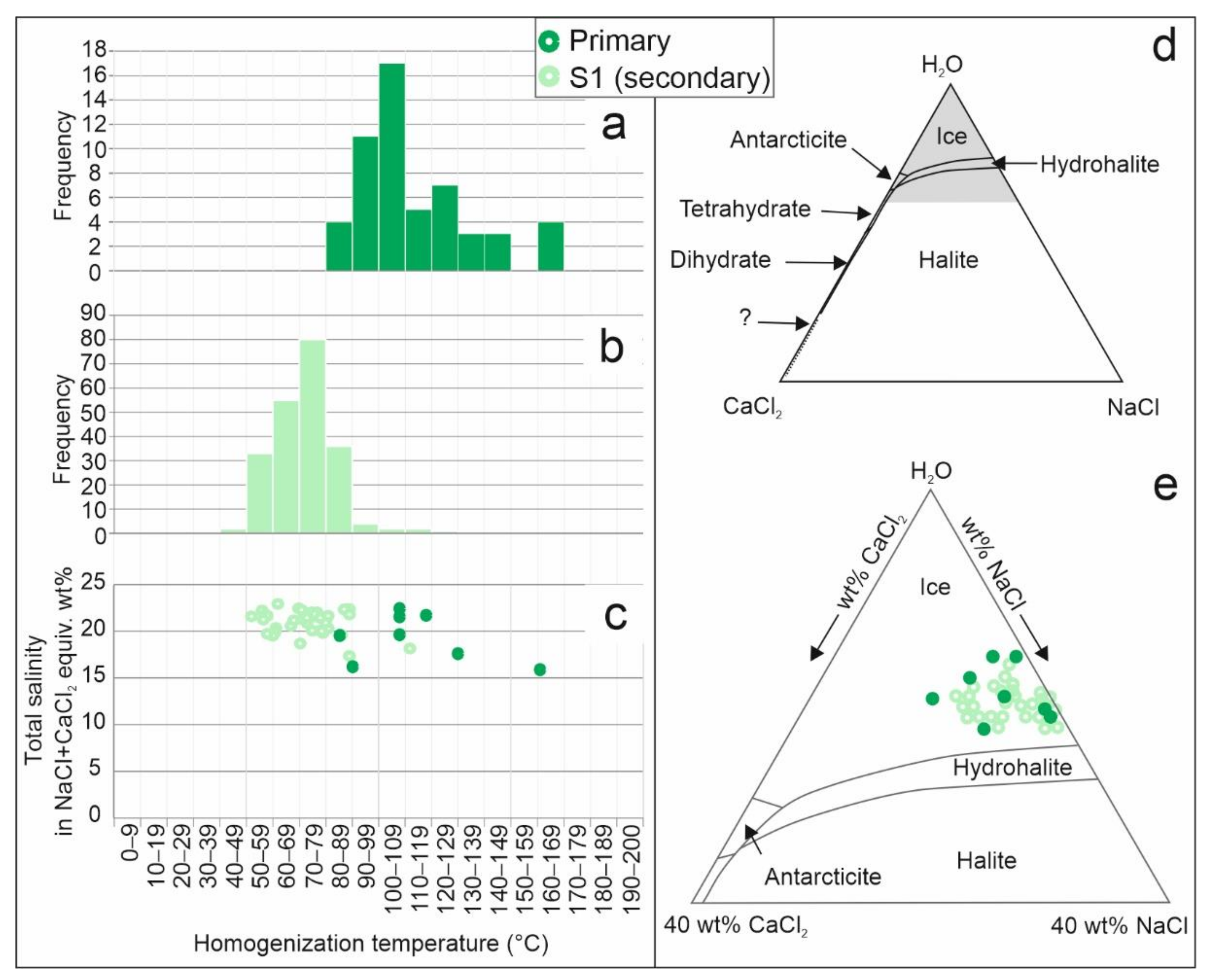
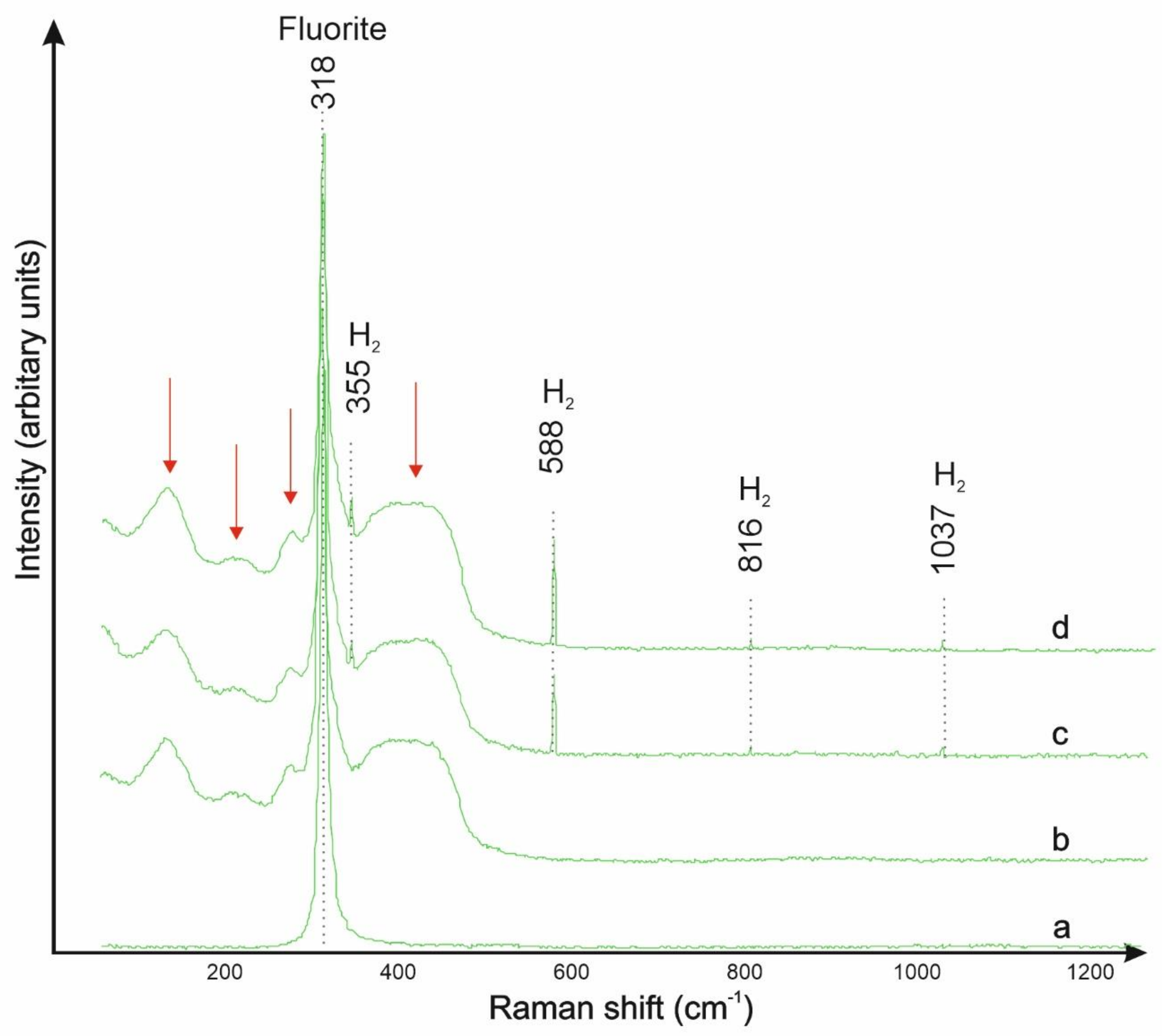
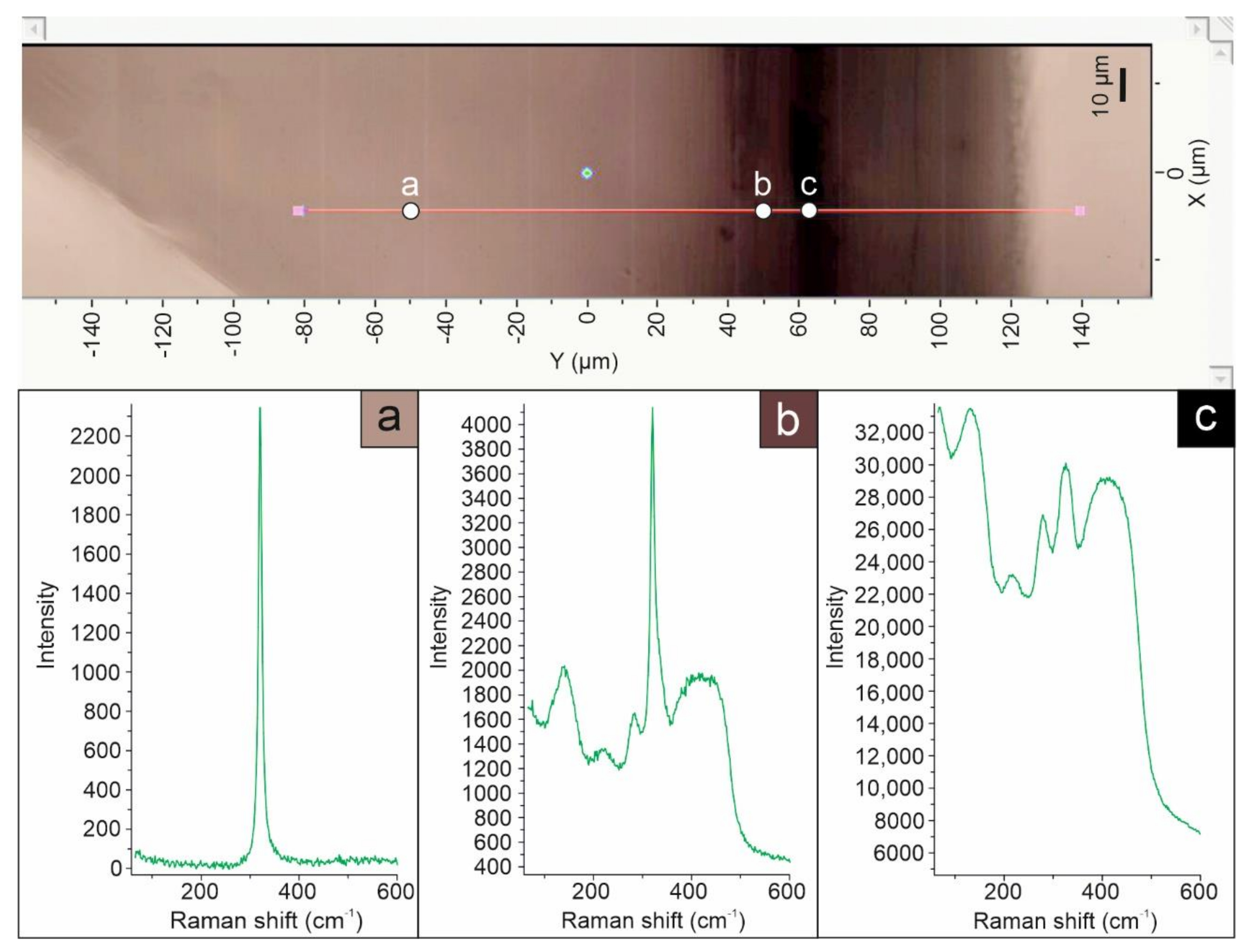
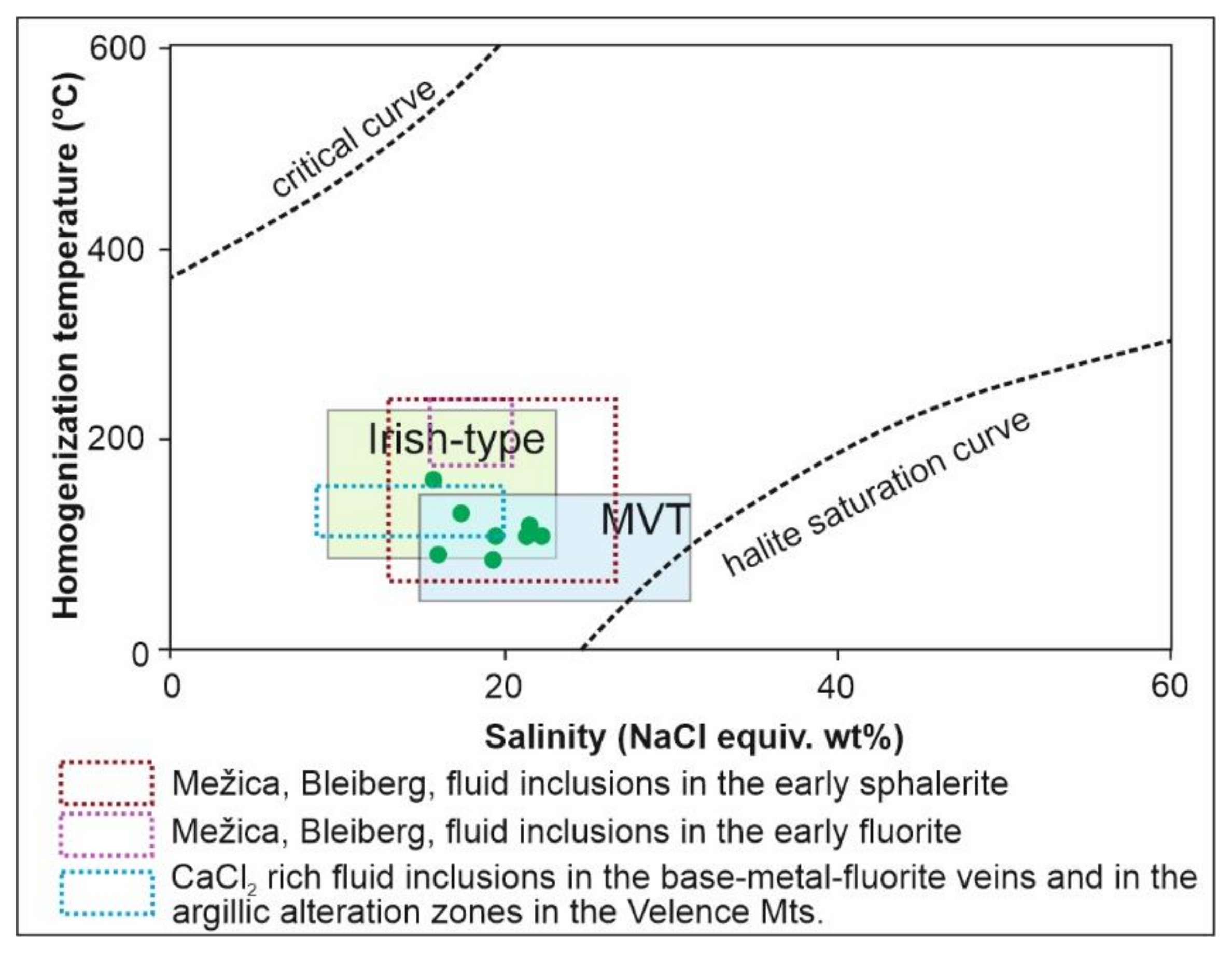

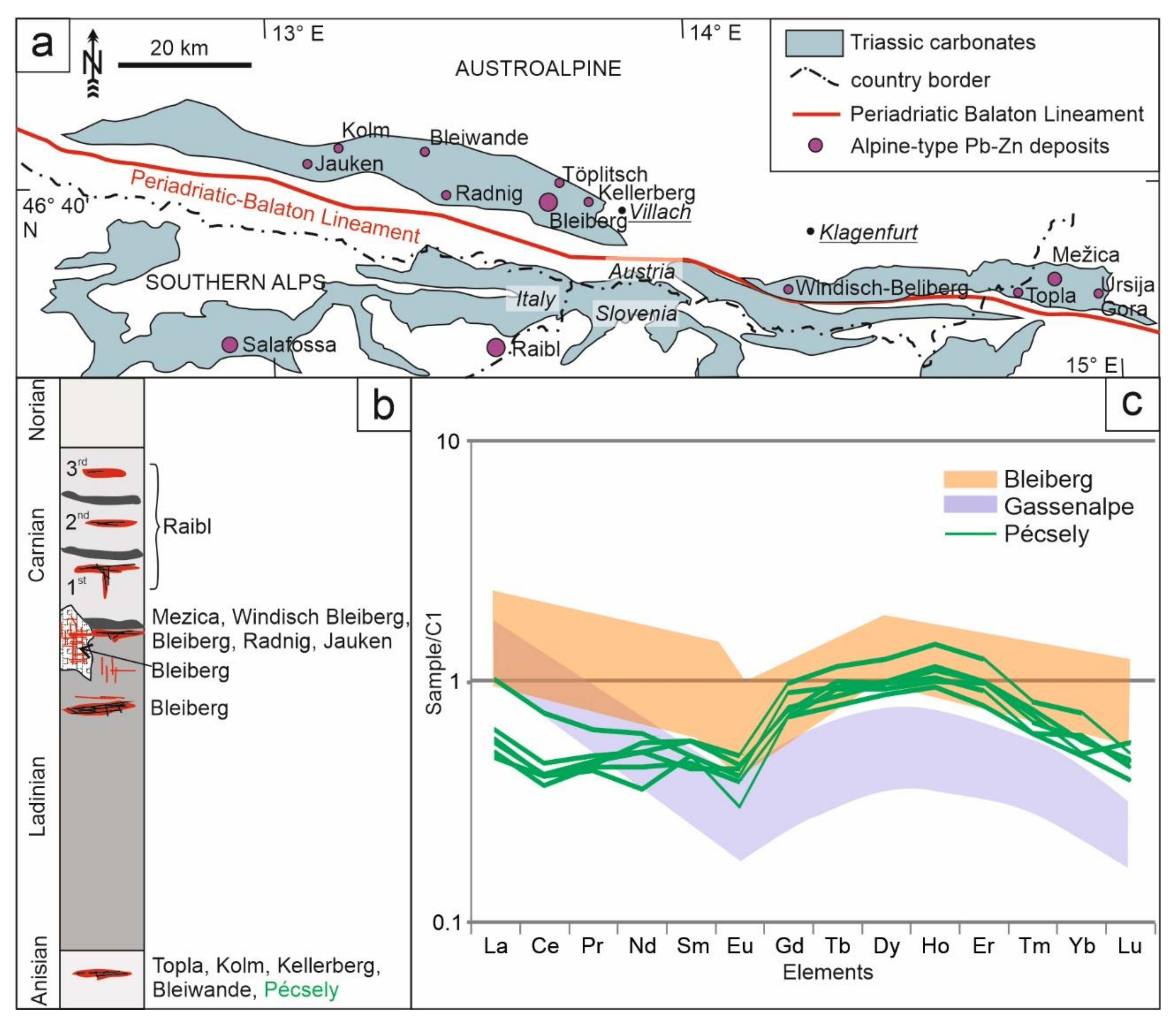
| Number | δ13CPDB (‰) | δ18OPDB (‰) | Number | δ13CPDB (‰) | δ18OPDB (‰) |
|---|---|---|---|---|---|
| 1 | 1.92 | −7.46 | 13 | −4.12 | −7.36 |
| 2 | 1.62 | −7.63 | 14 | −3.78 | −7.41 |
| 3 | 1.66 | −7.66 | 15 | −4.07 | −7.39 |
| 4 | 1.57 | −7.69 | 16 | −3.05 | −7.45 |
| 5 | 1.57 | −7.58 | 17 | −7.11 | −6.93 |
| 6 | −6.91 | −7.12 | 18 | −6.79 | −6.78 |
| 7 | −7.16 | −7.15 | 19 | −7.15 | −6.92 |
| 8 | −1.63 | −7.54 | 20 | −5.78 | −7.36 |
| 9 | −3.08 | −7.50 | 21 | 1.85 | −7.17 |
| 10 | −5.60 | −7.51 | 22 | 1.91 | −6.76 |
| 11 | −4.71 | −7.79 | 23 | 2.12 | −7.58 |
| 12 | −4.24 | −7.44 | 24 | 2.09 | −7.53 |
| Primary | Secondary | |||
|---|---|---|---|---|
| S1 | S2 | S3 | ||
| Number of measurements | 55 | 218 | 29 | - |
| Size | 5–30 μm | 5–15 μm | 5–30 μm | 5–10 μm |
| Shape | rectangular (negative crystal shape) | angular | irregular | roundish |
| Phases | 85% L + 15% V | 95% L + 5% V | 95% L + 5% V | 100% L |
| Th | 85–169 °C | 42–121 °C | 45–65 °C | - |
| Teut | −57.7 to −44.0 °C | −58.0 to −46.0 °C | - | - |
| TmeltHydrohalyte | −26.5 to −21.5 °C | −25.0 to −21.2 °C | - | - |
| TmeltIce | −21.0 to −12.0 °C | −20.8 to −13.7 °C | - | - |
| Apparent total salinity | 15.91–22.46 NaCl wt% | 17.35–22.93 wt% | - | - |
| Calculated salinity | 0.64–9.98 CaCl2 wt% + 9.59–20.64 NaCl wt% | 0–8.47 CaCl2 wt% + 12.4–20.01 NaCl wt% | - | - |
Publisher’s Note: MDPI stays neutral with regard to jurisdictional claims in published maps and institutional affiliations. |
© 2021 by the authors. Licensee MDPI, Basel, Switzerland. This article is an open access article distributed under the terms and conditions of the Creative Commons Attribution (CC BY) license (https://creativecommons.org/licenses/by/4.0/).
Share and Cite
Molnár, Z.; Kiss, G.B.; Molnár, F.; Váczi, T.; Czuppon, G.; Dunkl, I.; Zaccarini, F.; Dódony, I. Epigenetic-Hydrothermal Fluorite Veins in a Phosphorite Deposit from Balaton Highland (Pannonian Basin, Hungary): Signatures of a Regional Fluid Flow System in an Alpine Triassic Platform. Minerals 2021, 11, 640. https://doi.org/10.3390/min11060640
Molnár Z, Kiss GB, Molnár F, Váczi T, Czuppon G, Dunkl I, Zaccarini F, Dódony I. Epigenetic-Hydrothermal Fluorite Veins in a Phosphorite Deposit from Balaton Highland (Pannonian Basin, Hungary): Signatures of a Regional Fluid Flow System in an Alpine Triassic Platform. Minerals. 2021; 11(6):640. https://doi.org/10.3390/min11060640
Chicago/Turabian StyleMolnár, Zsuzsa, Gabriella B. Kiss, Ferenc Molnár, Tamás Váczi, György Czuppon, István Dunkl, Federica Zaccarini, and István Dódony. 2021. "Epigenetic-Hydrothermal Fluorite Veins in a Phosphorite Deposit from Balaton Highland (Pannonian Basin, Hungary): Signatures of a Regional Fluid Flow System in an Alpine Triassic Platform" Minerals 11, no. 6: 640. https://doi.org/10.3390/min11060640
APA StyleMolnár, Z., Kiss, G. B., Molnár, F., Váczi, T., Czuppon, G., Dunkl, I., Zaccarini, F., & Dódony, I. (2021). Epigenetic-Hydrothermal Fluorite Veins in a Phosphorite Deposit from Balaton Highland (Pannonian Basin, Hungary): Signatures of a Regional Fluid Flow System in an Alpine Triassic Platform. Minerals, 11(6), 640. https://doi.org/10.3390/min11060640







